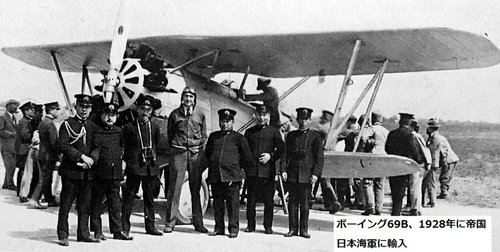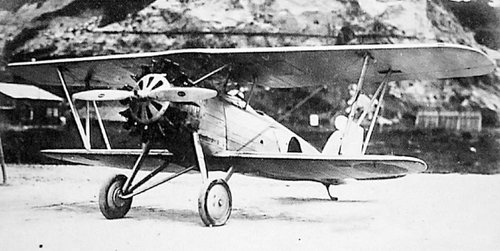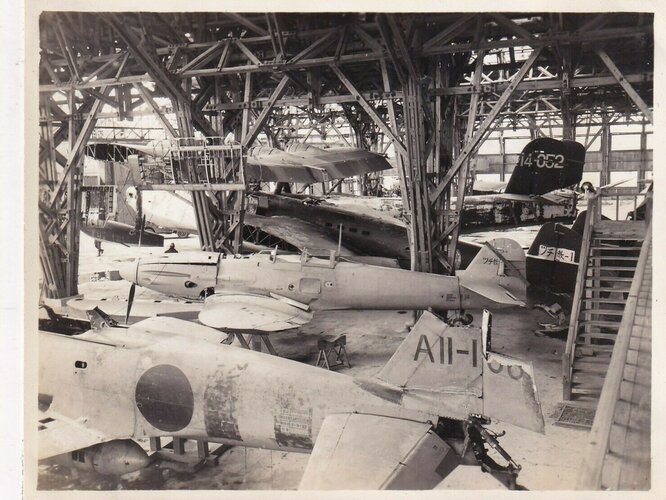tom!
ACCESS: Confidential
Hi.
From the Research Topics - Designations Systems Forum part:
Are there any further data/infos/pics in japanese service available on these IJN experimental aircraft?
Yours
tom!
From the Research Topics - Designations Systems Forum part:
Update of Skyblazer's list of IJN evaluation types (reply#1)
• (None) “Boeing Carrier Fighter” = Boeing Model 69B (c/n 1034 or 1035) with 425hp P&W R-1340-8 Wasp (export F2B-1)
• AXB Type B Carrier Fighter = Boeing Model 100 (c/n 1145; NX874H) with 450hp P&W R-1340-B Wasp (export F4B-1 with P-12D features added)
• AXD Type D Carrier Fighter = Dewoitine D.510J (c/n 1J or 2J) with 860hp Hispano-Suiza 12Ycrs
• AXG Type G Carrier Fighter = Canadian Car & Foundry GE-23 Goblin (c/n 102) with 890hp Wright R-1820-F53 Cyclone (license-built Grumman FF-1 development)
• AXH Type H Carrier Fighter = Hawker Nimrod 1 with 477hp Rolls-Royce Kestrel IIMS
• AXHe Type He Interceptor Fighter = Heinkel He 100D-0 (c/n 3007; D-ITLR) with 1160hp DB-601M
• AXV “Vought Corsair” Fighter = Vought O2U-1 with 450hp P&W R-1340-88 Wasp
• AXV (2nd) Type V Interceptor Fighter = Vought V-143 (c/n 1228; NR56V) final rebuild with 825hp P&W R-1535-SB4G Twin-Wasp Junior
• A7He1 Type He Air-defense Fighter = Heinkel He 112B-0 with 630hp Junkers Jumo 210C (twelve in service - all used for evaluation and training)
• A8V1 Type S Two-seat Fighter = Seversky 2PA-B3 with 1,000hp Wright R-1820-G2 Cyclone (twenty briefly in service)
• BXN1 “Northrop 2E Attack Plane” = Northrop Gamma 5A (c/n 187; NX14997) with 775hp Wright R-1820F-52 Cyclone and trousered landing gear.
• BXN2 “Northrop 2F Attack Plane” = Northrop Gamma 5D (c/n 291; NX16091) with 600hp P&W R-1340-S3H-1 Wasp and retractable landing gear.
• CXP “Diesel Engine Experiment” = Potez 25x with 500hp Clerget 14F-01 radial diesel engine
• DXD Type D Bomber = Last-produced Northrop BT-1 (c/n 346; USN BuNo. 0643 – damaged and then sold as “Douglas DB-19” (NX18995) following post-accident rebuild by Douglas)
• DXHe Type He Bomber = Heinkel He 118V4 (c/n 1296; D-OMOL) with 1070hp DB-601A
• HXC Type C Flying Boat = Consolidated Model 22 Ranger P2Y-1J (NX21966) with 2 x 575hp Wright R-1820-1 Cyclone
• HXD Type D Flying Boat = Douglas DF-151 (likely c/n 1501 and c/n 1502)
• HXP Type P Flying Boat = Potez 452 with 350hp Hispano-Suiza 9Qd
• KXA1 Type A Intermediate Trainer = North American NA-16-4R (NA-37; c/n NA-37-539) with 400hp P&W R-985 Wasp Junior and fixed landing gear
• KXA2 Type A Intermediate Trainer = North American NA-16-4RW (NA-47; c/n 47-696) with 330hp Wright R-975E3 Whirlwind and retractable landing gear
• KXBu Type Bu Primary Trainer = Bücker Bü 131B Jungmann with 105hp Hirth HM 504A-2
• KXC Type C Trainer = Caudron C.601 Aiglon Senior with 145hp Renault 4Pei
• KXHe Type He Trainer = Heinkel He 72B Kadett with 160hp Siemens-Halske SH-14A
• KXJ Type J Trainer = Junkers A.50ce (c/n 3552; D-3) with 99hp A-S Genet Major
• KXL Type L Trainer = Lockheed Model 10A Electra (c/n 1017) with 2 x 450hp P&W R-985 Wasp Junior SB
• LXC Type C Amphibious Transport = Curtiss-Wright CA-1 (c/n 101; NX13298) flying boat
• LXD Type D Transport = Douglas DC-4(E) (c/n 1601; NX18100) with 4 x 1450hp P&W R-2180-S1A1-G Twin Hornet
• LXF Type F Amphibious Transport = Fairchild Model A-942B (c/n 9404; NX16359 and c/n 9406; NX19130) flying boat with 875hp Wright R-1820-F52 Cyclone
• LXG "Gasuden Passenger Plane" = Gasuden KR-2 Chidori-go development of the de Havilland DH.83 Fox Moth (twelve built – several taken into IJN service)
• LXHe Type He Transport = Heinkel He 70
• LXJ Type J Transport = Junkers Ju 160D-0 (c/n 4248; D-UZUL) with 730hp BMW-132E2
• LXJ (2nd) Type J Transport = Junkers Ju 86Z2 with 2 x 845hp BMW 132Dc (the first [M-211] of 14 in Manchukoan service)
• LXK Type K Transport = Kinner C-7P Envoy (c/n 194; NX14930) with 340hp Kinner R-1044-2
• LXM "Airspeed Envoy Transport Plane" = Airspeed AS.6A Envoy I (likely c/n 41 – one of six imported by Mitsubishi for NKYKK) with 2 x 240hp A-S Lynx IVC
• (None?) "A20A Boston" Bomber = Douglas DB-7B Boston III (c/n 3836; RAF# AL904) captured DEI 1942 (IJN marked [Ko]-DA-1)
In 1940 or 41, two He-119 light bomber prototypes (possibly V7 and V8) were imported for evaluation by the IJN and subsequently flown at Yokosuka. Due to the destruction of documents in both Germany and Japan, the experimental designation of these aircraft and the results of the test program are not known.
Are there any further data/infos/pics in japanese service available on these IJN experimental aircraft?
Yours
tom!






















